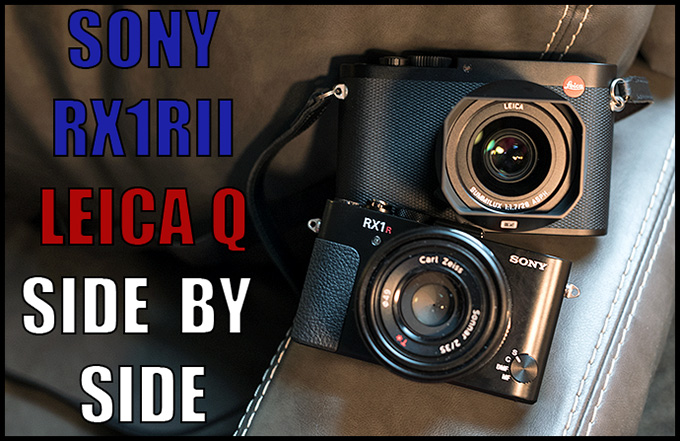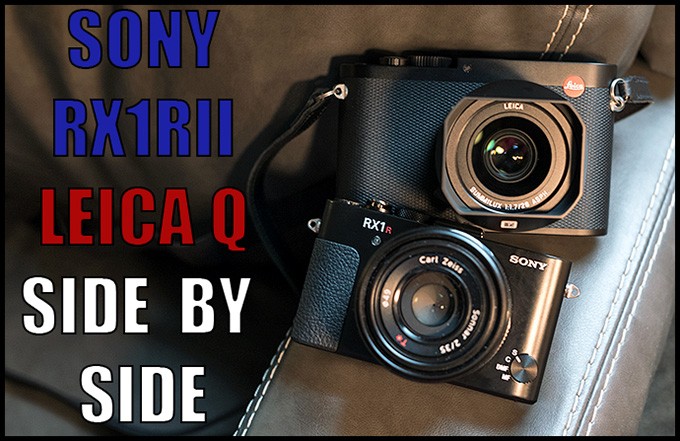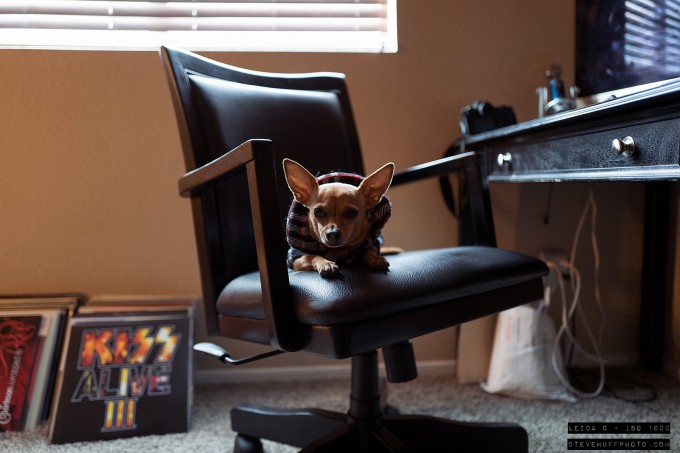
VIDEO: Side by Side: Sony RX1RII and the Leica Q. Which would I buy?

Below is a video I just whipped up showing the Sony RX1RII next to the Leica Q. I go over the features, pros and cons of each and state which one I would buy and why. Take a look below! Full RX1RIi review next week 😉
You can buy a Q at B&H Photo or Ken Hansen (email: khpny19@aol.com) or PopFlash.com
THREE shots. One from the RX1RII, one from the Q, and for fun, one from the Leica SL with 50 Lux attached..
1st shot, Sony RX1RII. She was sleeping but I got her attention after this one…click it to see the overall rendering of this camera. Lower contrast, plenty of DR and a nice gentle way or rendering fine details..shot at f/2. THIS is amazing IQ. Rich, detailed, with soul.
–
Now the Q, from RAW, same ISO of 1600 as the RX1RII but shot a t f/1.7. A bit “harder” than the RX1RII and darker. I prefer the Sony shot for rendering here.
–
And for fun, the Leica SL with 50 Summilux ASPH at f/2. By this tie she was saying “C’mon Dad, enough of these tests already”! I love the SL, and for me it is the best of all but it should be at the price 😉






How times can change.
He looks like Master Yoda!
Cute, he is.
the M produces images which are dirtier, less clean results. And you call that “soul”? If it weren’t a Leica, you would probably downgrade the camera for this. For this price, I understand why you might see the flaws as “character”.
Thank you!!!
How serious is the Q banding issue when puling the shadows?
Which one has the best ‘pop’ / subject isolation?
I looked carefully at all. I was split 50/50 until the last couple of grocery store shots where I saw much nicer Bokeh from the Sony, and a tad more life to the image. BUT both are wonderful. Sony wins at high ISO without question. Leica has better ergonomics to most and is easier to use. I prefer the Sony for the $1k price savings and overall slightly different IQ rendering that I prefer to the 28mm on the Leica, and its more usable low light and has a swivel LCD. But the $1k savings is big IMO.
RX1Rii / Leica Q street shooting comparison
None of these will win any awards. And, I didn’t do any major editing on them. I’m comparing the Sony RX1Rii and the Leica Q and yesterday I went out to the streets of San Antonio and snapped these.
Please keep in mind:
– Images may have been cropped or straightened slightly.
– I may have edited highlights and shadows, but I didn’t alter the color at all (ie: saturation).
– Each comparison is consistent: Sony RX1Rii is on the left, Leica Q is on the right.
– I would really appreciate your thoughts. As hard as it will be, please try to judge the images on image quality; not what a great or crappy shot it is. So for instance, you may like a subject’s facial expression more on the left. But, on the right, you may really like the depth of field or image saturation or whatever. If that’s the case, pick that one.
What do you think overall? The RX1Rii on the left, or the Leica Q is on the right?
Dropbox link: https://www.dropbox.com/sh/0q3uxegegtofonu/AADoZEf20JOrg5YkDJzFMDyKa?dl=0
The RX1RII is not a “pro” camera..as in, it is not meant for sports, weddings, concerts..and while it can be used for these things, Sony never said the RX1RIi was a pro solution. It’s a casual everyday camera great for family, vacations, street shooting and even portraits when you want the best IQ possible in the smallest form factor. It’s not a DSLR or action camera, so no need for a back Af button on this guy.
I say “of any 35mm full frame camera”. I mention full frame and 35mm. MF… I would NEVER take a MF over the SL, ever. They are clunky, slow, large, have awful ISO capabilities, are not made for handheld shooting. They are studio and landscape cameras 1st and foremost not street, casual or everyday cameras. Not even comparable in any way at all. With that said, I had three MF cameras here – top end Phase, Pentax, and Mamiya. Not a fan at all which is why I never reviewed them. So a MF rig is something I would never use or own for myself as they are much too limited.
Hi Steve, could you do fun comparison with the Q and RX1RII in crop modes tto 50mm vs SL with the 50mm without noting what lens is what in description?
Thanks.
+1
Forget the cameras, I love your dog. 🙂
It is always fun and interesting to read your site and reviews, Steve! One question though. You say that the new Leica SL has the best image quality of any digital camera you have ever seen. But what about medium format? I cannot imagine the best 35mm sensor could ever really compare with the best medium format It is really hard for anything in 35mm to compare to a Phase One, Leaf, or Hasselblad digital back, especially the newer ones. Or even the Pentax 645Z. I have shot extensively with both medium format and 35mm, and on a large monitor, the IQ difference is clear.
My personal feeling is that for the price of the Leica SL people could – and maybe should think about – buy the Pentax 645Z and 55 2.8 lens or a used Phase One or Mamiya or Hasselblad, and the image quality would almost surely be superior (but of course it is much bigger , less flexible, and a totally different thing). But if we are talking about image quality, it is important to bring up medium format too.
Or are you referring to 35mm only?
Sony is telling me that the RX1R2 doesn’t have back button focus. This can’t be true. I don’t know a pro using AF who doesn’t use back button. It’s not a deal breaker, but its absence would be idiocy. I hope you cover this in your full review. Your preview here was tantalizing.
a pimp ? Not true
Michiel, I’ll answer this question for Laaba on why the RX1 series has a poor implementation of focus-by-wire.
1) The focus setting/distance resets to infinity every time the power is turned off. A lot of shooters that enjoy manual focusing like to zone-focus (or pre-focus) This allows the shooter to set the aperture to F5.6-F8, turn the focus ring to a set distance, and have everything from 1.5 meters and on wards in focus. It is the quickest way to shoot on the street because it allows to shoot without focusing.
2) The focus ring on the RX1 is not linear. The focusing is variable and speed-dependent. What this means is that the faster you turn the ring, the faster the focus distance changes. It is not intuitive and it is the reason why a lot of people dislike focus-by-wire systems.
The Leica Q is brilliant because it employs a focus-by-wire system yet the the focusing is linear with a proper DoF scale on the lens. Manual focusing with the Q is a joy, and the RX1 doesn’t even come close in this regard (in fairness, along with almost all other mirror-less cameras)
Your dog is a pimp
Steve – Thanks for your great reviews. I’m looking forward to reading your full review. Quick question – how does the noise/high ISO performance of the the A7rii versus RX1Rii versus Leica Q compare?
“higher contrast, more accurate colors” that seems like a perceived color accuracy.
http://www.stevehuffphoto.com/2015/12/08/update-my-rx1rii-review-should-be-up-within-7-10-days/
I can’t wait 18th . Omg !
+1
I’ve seen several people quoting your error and passing it off as fact, it also doesn’t give huge confidence you even wanted to evaluate the Q fairly.
I just do not understand why the Sony RX1R II does not have a built in ND Filter.
would it make IQ worse or what, anyone have the answers to this Question Please.
I said by FRIDAY this week. Will be up by end of week. Today is the 14th anyway, not the 15th.
Some sort of Camera-Valhalla of the past loves seems like a great thing to realize ! Now there’s a reason to be a millionaire.
RX1RIi review next week?
You said 15 December .
I can also keep my Sony rx1r and save the money for a new camera next year . In a couple of moths new cameras will come out. I am only so sick of the slow AF of the sony rx1r
I think that you should correct your video and review, the Q does f/1.7 from 1 foot to infinity.
So no automatic stop down to f/2 ou f/2.8 at normal range.
It is not like the X typ 113.
However it does stop down to f/2.8 when we engage the macro mode on.
+1
Of course the Q image is darker, you have the window in the image so it’s going to compensate for that with the overall exposure.
Ummmm. Whatever you like. It allows you to get in close, so anything that you want to get close to 😉
Steve, could you at least correct your previius comments regarding the “variable aperture?” It really makes the Q look bad because people will think they can’t get shallow DoF for close up shots. Thanks!
hi steve so what kind of photos would i take with the Macro mode on the RX1RII??
THANKS
This is true. The Leica’s always have a way of rendering images in that unique way, which is what draws many people to them and the brand. “The Leica Look” is real. 😉 I wouldn’t call the RX1RII files lifeless by any means though, as they have tons of life and character themselves, just a different kind of character than the Leica.
Well, best quality would be Extra Fine.
The Q is already selling for $3650 on the used forums. Certainly not appreciating 25%….
Sure the Q does not stop down to 2.8 if you use normal mode and not macro mode.
For a faire comparison you should use the same perspective. Sure within the Q picture you are not so close to the object like with the other two. Due to this the light from the window influences the metering.
If I have to choose between Q and Sony then for sure I will prefer the Q for the much better usability and M feeling. The Q looks like a Bauhaus camera where the Sony looks like a lego build camera.
100% correct Steve. Don’t get carried away with a camera body, even if it’s ‘Leica’! The M9 was there first real “classic” digital camera and it has dropped less quickly due to it’s CCD sensor and people preferring this (if inclined) over the M240.
A digital camera body (vs. a lens) regardless of brand is not an “asset”!
Hi Steve, just wondering for a normal camera shooter not a lot of editing, if you had to shoot your camera in jpeg is there a big difference in Fine and Extra Fine? Which one would you go with ?
THANKS A LOT
I would have liked to see the first and third shot together. Same angle of view for a better comparison.
I’ve had both the RX1 and Q along with the a7ii. I often describe the Sony Zeiss look as clinical. Plenty of detail and DR, but can be a bit lifeless. Leica tends to evoke a more nostalgic feeling to me. Not sure if it’s the color or it looks more natural to me or what. I see the same thing when I compare the Zeiss FE 55mm with an old Minolta 50mm. Both produce wonderful results, but each has a different character that evokes a different feeling.
How would the A7RII stand up in this contest?
I normally don’t pixel peep on these tests, but I did on this one. That SL is amazing, even at the pixel level, the color and contrast are the best I have ever seen. (For the price, though, I think I would just hire someone to follow me around and take my family pictures.)
The other two cameras are easily better than anything I have ever shot with, but I am wondering if the A7R2 is within striking distance of this kind of quality.
Laaba, I don’t know the camera at all, but why turn it off during a shoot? Auto turn-off, battery life? Autofocus changes back to ??? when the camera is turned off?
really hard to compare these shots even slight changes of position of subject and camera positions change look and feel more than cameras
Hi Steve..many thanks for that review…please the transparent and objetive possible..overall..side by side and by its features and weakness..tell us your determinant choice; thinking in RAW not Jpegs.
Regards.,
Ricardo
Nope. It still has the same issue in regards to MF in that area. It will not keep your MF setting when off. If this is how someone would shoot, then this is not the camera for them. 🙂
At more than double the price, when you include a comparable lens, the SL should be better than the Q. But it’s not suppose to be a substitute. Apples to apples.
He has stolen it from me by reading my thoughts!
Try both. I do not shoot food much but would think normal mode would be best. Macro mode you would get close but the DOF would be too shallow.
No, I do not see a HUGE difference in IQ between the old RX1R and the new one. The main differences are its faster in all aspects, has the EVF which is very very nice to have, I use it 95% of the time with it, it has more resolution. It will also be a little better in low light/high ISO. But the general RX character is there due to the lens being the same. I do not see a reason to have a Q and an RX1R as the difference between them is very small, and I feel the IQ of the old RX1R edges out the Q as well. But the Q is more pleasing to use over the old one due to the faster speed and EVF. If I had an RX1R…well…I’d either sell for the Q or for the new Sony 😉 I would not keep both as 28 and 35 are very close and you would be using the Q more due to its speed and EVF. Tough call. I slightly prefer the Sony RX1rII to teh Q due to the sensor and IQ. You can not replicate the RX1R style with the Q, and vice versa. I guess go with what image rendering you prefer.
Id say DP Review either has a bad copy or as I said before, is doing something incorrectly which seems impossible. They know what they are doing. In my tests, the RX1RII is sharper than the Q (though not by much) and I will have plenty of real world (not studio) samples in my review. With that said, I love both of these cameras. If I were a multi millionaire I would build a room with glass cases just to hold all of the cameras I have fallen in love with over the years. 🙂 I like shooting the Q though, its quick, fun and gives you back wonderful IQ. The RX1RII is the same but different as when shooting it, it’s a little less snappy (so Q wins that) but the files are so different. Only the true photo geeks (like me) will find a weakness in either.
Sony has made a grand total of three RX1 models in 3 years. Two in 1st year (for separate purposes, both offered at the same time), and now the replacement for both in one model. Hardly 10. It’s a superior camera to the Q if you care about technicalities and versatility. The Q is superior if you care about the name and prefer the design. The Leica Q will go down in price as well, all Leica digitals do. In fact, no Leica digital EVER appreciated even 1% let alone 25%. Not sure where you received that info/myth. In about a year the Q will be selling used for $1800. You can get an M8 today for $1000, an M9 for $2300 and an M 240 for $3500 if you look around. These all sold for $7-8k when new. So they have all depreciated by 50% and more. You will never have a Leica digital appreciate by 25% unless we are talking keeping it in a glass case for 50 years and it being a limited edition, 1 of 25 sort of thing. The old S that sold for $26k now goes for $4k used. I rest my case.
Hi Steve thank you for the comparsion. One Question, I had the RX1 for a while an still think it had one of the best imagequality. But for me it was annoying that everytime I turned off the camera I lost my focus settings. So it was very difficult to use this camera for streetshooting with zone focusing. I guess the camera has still the same focus by wire technology but maybe they solved the problem otherwise?
If you want the best, I would get this one:
http://www.bhphotovideo.com/c/product/1109957-REG/heliopan_704990_49mm_variable_gray_nd.html
I own this one and its fantastic.
Me too 🙂
Hey Steve, thanks for video.
What strength ND filter would you recommend for the RX1RII?
Cheers, Ben
I can also confirm that the Q only stop down in macro mode. I’m an old RX1 shooter, but changed to the Leica Q when it came out. Been trying out the RX1R II in the shop, but don’t think I’ll buy it. I like the IQ of both, but the implementation of the manual focus on the Q and the user interface in general, make the Leica Q the dream camera for street and photo journalism. The RX1 and the RX1R II both have a very slow and unresponsive focus by wire system, that together with the fact that there are no hard stops on the focusring, make the RX1 more or less useless for manual focus. My one complain with the Leica Q would be dynamic range, it’s to easy to burn the highlights.
If the Money are not the only reason i would prefer LEICA. Did you wait one or two years SONY is an old Piece of crap because they have made 10 new models. There is no upgrade for older models…..and the Price is going down at 60 % or more. But LEICA will increase maybe 25 %.
Look inside you must.
I am still puzzled by the sharpness difference of the Q vs RX1RII on the dpreview comparisons, but having owned the RX1R I know that it’s a beautiful lens which a great bokeh. So I have the II on order and look forward to having even richer files to work with than with the old RX1R.
The Q is bigger, very nice, maybe more representable ?
File richness (DR/MPixels) and size were the differentiators which made me buy the Sony.
Last one reminds me of Yoda
Patrick, did you forget the quotation marks and credit or are you Thorsten Overgaard?
http://www.overgaard.dk/Leica-28mm-Summilux-M-ASPH-f-1-4.html. , see a couple og paragraphs under heading “The “Leica Glow” and the Leica philosophy on lenses”
Steve, do you see a big difference between the IQ of sony rx1r and rx1rii?
Why am I asking you this?
I have 2 options:
Option 1: I have the rx1r and can sell it for 500 pond (EVF included) , and than I would buy the new rx1rii. My biggest frustration with the rx1r is the AF, but love the IQ.
Option 2 : Or I will keep my old rx1r and buy a leica Q , than I have a 33mm (slow AF) and a 28mm(fast AF and I would love to have a 28 mm , my photos are inspired by Winograd, have a look at my website…)
Wich option would you chose ? 😉
Jan
Hey Steve for the RX1R II would you recommend using Macro mode for food or sticking to the original (0,3m-oo) or it doesn’t really matter in AF.
I bought the rx1rii a couple of days ago. I shot 5 assignments with it and am very very impressed. I tested the SL and Q as well and prefered the Q body, nearly started crying beacause of the SL’s OVF but decided on the rx1rii because it best siuted my needs. So far i think it is a precision instrument that did not kindle my passion immediately. Its AF is reasuringly dependable, and the eye AF leaves me speechless at times
: ) I am looking forward to shooting more with it, especially once i updated my CC to develop its raws.
That my sound like a silly comment, but I agree as well. I have a Sony Rx1 and Leica M. The RX1 produces incredible images, but if you might say sterile, the M produces images which are dirtier, less clean results, but seem to have more soul as you said. Maybe is buyers remorse because of the price of the cameras 🙂
I can confirm that having just tried it as close as 0.9ft. i.e. less than a foot from the subject.
The Q`s lens fully opened up does not automatically stop down to 2.8 when getting close to the subject, but remains @1.7. It`s the X116 which does that. The Q goes to f2.8 only in macro mode
Great video Steve. Just what I was looking for.
That said I like the Sony shot the best
This is a really tough call between the two for me and Im a Leica fanboy. Impressive regardless.
In Europe, the Leica Q costs just 400 € more than the Sony RX1 R II. And what often is forgotten: the Q has a full license for Adobe Lightroom (plus 298 $) and a full metal lans cap (for Sony RX1 R II not included, if you want the Sony original: plus 170 $). And a 2 year warranty instead of 1.
I explained this three times now on this site. The SL uses teh Q sensor but it has been optimized for the SL, as in, the IQ is different indeed,,much more refined and of course we have all kinds of lenses to choose from, which is 75% of the IQ, so teh SL and Q will NEVER look the same IQ wise. The SL has the best IQ I have seen from ANY Digital camera ever made. RX1RII and A7RII next, then the Q. I have them all here and have shot them all extensively. These are my opinions. Thank you. But there is much more to a sensor than the sensor. How it is implemented make all the difference in the world.
Which is why the images here are all RAW. I said in the video, always shoot RAW but the Leica Q JPEGS come out rich and full of the Leica character. In RAW you lose that processing but have much more control over the final result. I always shoot RAW.
If I look at a Zeiss image, I see extreme sharpness but an overall dead image. For me, that is optics designed by a computer. What I think distinguish Leica is that some human make decisions on the road to the final design.
A computer can figure out the sharpest lens, but only a human can figure out a lens that makes things look alive.
This might be a accurate, or less accurate description of the phenomena. If you are into Leica lenses, you know of the Mandler era: That is lenses designed by Dr. Walter Mandler who worked at Leica Camera AG and who’s lens designs are characterized by a soft look, but at the same time very detailed. He did the 75/1.4, the 50/2 version II, the Noctilux f/1.0 and many more lenses. If you said his lenses didn’t focus on sharp edges, but on many details, you would be on the right track.
Since then, Peter Karbe has taken over and is the one in charge of the design of Leica lenses these days. The new lenses has much more control of micro-details, light-rays and the overall result is higher contrast, more accurate colors and an overall apparent sharpness. One other thing that distinguish Leica lenses from other brands is that they cut no corners in lens design and production. This is why – surprisingly – new lens designs are better than older ones. “They don’t build them as in the old days” is true for many things in life, but not for Leica lenses.
Sharpness is not a sharp edge, but is perceived sharpness; meaning that the idea that something is sharp and detailed due to the light conditions. It comes down to the control of light rays (Red, Green and Blue) and how they meet on the sensor plane.
The Leicas have character, the Zeiss has… soulless perfection.
I’ve heard that the OOC jpg’s from the Q are not very good and you need to shoot raw to get the best IQ from the camera. I like the jpg’s out of my RX1. Any thoughts on this, Steve?
Because I already have the original RX1, I opted to keep it and buy the Leica Q. No regrets.
Does the sony have a leaf shutter to do high speed sync?
From the max shutter speed i would assume the leica is focal plane shutter…
OK Steve, how can you rank the SL IQ higher than the RX1 and A7r and the Q last when the SL and the Q have the same sensor and the Q has the advantage of a lens optimized to the sensor? This doesn’t make sense unless Leica intentionally made the Q image processing worse than the processing on the SL (they also use the same Maestro processor).
Leica Q for me I actually tried both for half hour each at bh and Leica shop. I like the feel of the Leica more. I like ls a7r ii more than the rx1r ii also.
I mean TL;DW
TL;DR please.